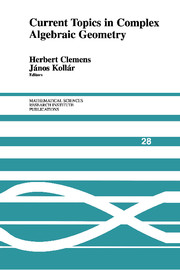Book contents
- Frontmatter
- Contents
- Preface
- Fundamental Groups of Smooth Projective Varieties
- Vector Bundles on Curves and Generalized Theta Functions: Recent Results and Open Problems
- Recent Results in Higher-Dimensional Birational Geometry
- The Schottky Problem: An Update
- Spectral Covers
- Adjoint Linear Systems
- Torelli Groups and Geometry of Moduli Spaces of Curves
- Vector Bundles and Brill-Noether Theory
Fundamental Groups of Smooth Projective Varieties
Published online by Cambridge University Press: 27 June 2025
- Frontmatter
- Contents
- Preface
- Fundamental Groups of Smooth Projective Varieties
- Vector Bundles on Curves and Generalized Theta Functions: Recent Results and Open Problems
- Recent Results in Higher-Dimensional Birational Geometry
- The Schottky Problem: An Update
- Spectral Covers
- Adjoint Linear Systems
- Torelli Groups and Geometry of Moduli Spaces of Curves
- Vector Bundles and Brill-Noether Theory
Summary
This article is a brief survey of work related to the structure of topological fundamental groups of complex smooth projective varieties.
These notes, which are based on a talk given at MSRI in April 1993, are intended as a brief guide to some recent work on fundamental groups of varieties. For the most part, I have just tried to explain the results (often in nonoptimal form) and give a few simple examples to illustrate their use. Proofs are either sketched or omitted entirely. The basic question that will concern us is:
Which groups can be fundamental groups of smooth projective varieties ?
This is certainly of importance in the topological study of algebraic varieties, but it is also linked to broader issues in algebraic geometry. Let us call the class of such groups V. As an application of the Lefschetz hyperplane theorem [Mi], we can see that any group in V is the fundamental group of an algebraic surface, and in fact we can even arrange the surface to have general type. Thus failure to answer this question can be viewed as an obstruction to completely classifying algebraic surfaces (even up to homotopy).
I should mention that there is also a nice survey article by Johnson and Rees [JR2] that reviews much of the work done on this problem prior to 1990. My own view of the subject has been shaped, to a large extent, by conversations and correspondence with many people, of whom I would especially like to mention Paul Bressler, Jim Carlson, Dick Hain, Janos Kollar, Madhav Nori, Mohan Ramachandran and Domingo Toledo.
Information
- Type
- Chapter
- Information
- Current Topics in Complex Algebraic Geometry , pp. 1 - 16Publisher: Cambridge University PressPrint publication year: 1996
Accessibility standard: Unknown
- 1
- Cited by
